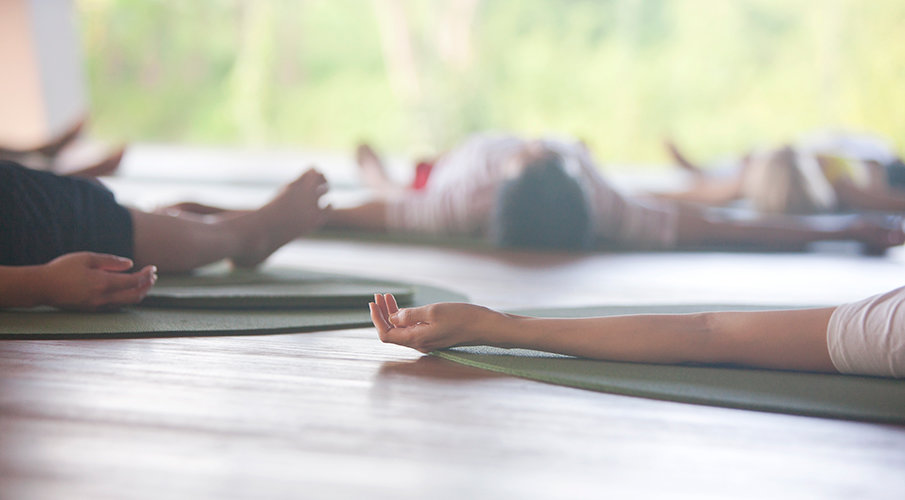This unconscious gripping is the work of the autonomic nervous system, or "fight-or-flight" response. Though few of us will face an actual saber-toothed tiger, the body's ancient physical reaction to attack remains a default setting in stress-filled modern times, says Judith Hanson Lasater, a teacher of restorative yoga.
But our intelligent human bodies also possess the ability to shut down an overactive stress response, she says. The parasympathetic nervous system triggers the "rest-and-digest" mode: the heart rate decreases, muscles relax, breathing slows, and blood pressure drops. Ahhh . . .
Fortunately, we can learn to activate the triggers that tell our bodies it's time to slow down. And with a little practice, we can train ourselves to remain in that relaxed state long term, Lasater says. The practice uses props and long, mostly supine, holds to passively open the body.
"Deep relaxation is not a pill to take, it is a powerful choice to make," she says. "We can change our mental state through our body and consciously choose a different way."
Try these steps to get your body to "rest and digest":
● Lying in child's pose, rest the center of your forehead on a yoga block. Putting pressure on the "third eye" stimulates the vagus nerve, the body's main messenger to the parasympathetic nervous system, regulating relaxation, heart rate, digestion, sleep, and well-being, Lasater says.
Comment: Learn about the Vagus Nerve and how the stimulation of the Vagus nerve (through breathing exercises) is an integral part of the healing benefits yoga:
- The Neurobiology of Grace Under Pressure: 7 habits that stimulate your vagus nerve and keep you calm, cool, and collected
What exactly is the vagus nerve?
The word vagus means "wandering" in Latin. The words vagabond, vague, and vagrant come from the same root. The vagus nerve is known as the wandering nerve because it has multiple branches that diverge from two thick stems rooted in the cerebellum and brainstem that wander to the lowest viscera of your abdomen touching your heart and most major organs along the way.
The vagus nerve is constantly sending sensory information about the state of the body's organs "upstream" to your brain. In fact, 80-90% of the nerve fibers in the vagus nerve are dedicated to communicating the state of your viscera up to your brain. When people say "trust your gut" they are in many ways saying, "trust your vagus nerve." Visceral feelings and gut-instincts are literally emotional intuitions transferred up to your brain via the vagus nerve.
As with any mind-body feedback loop, messages also travel "downstream" from your conscious mind through the vagus nerve signaling your organs to create an inner-calm so you can "rest-and-digest" during times of safety or to prepare your body for "fight-or-flight" in dangerous situations.
Your vagus nerve is the commander-in-chief when it comes to having grace under pressure. The autonomic nervous system is comprised of two polar opposite systems that create a complementary tug-of-war which allows your body to maintain homeostasis (inner-stability).
- Research Shows Vagus Nerve Stimulation Can Help Reorganize Brain
- Stimulating the vagus nerve: Memories are made of this
- Vagus nerve's role in regulating inflammation
● Use an eye pillow. The body's oculocardiac reflex, stimulated by gentle pressure on the eyeballs, is another "rest-and-digest" trigger.
● Take slow, deep belly breaths. This movement in the diaphragm stimulates the relaxation response, allowing neuroreceptors to send your brain messages that it's time for the body
to relax.
● Chant a mantra, like Om. Mantra chanting vibrates the muscles in the ear, face, and throat, which stimulate the vagus nerve for relaxation.
● Practice pratyahara—closing off the senses (including all stimulation through the eyes, ears, nose, and mouth) to enjoy a deep internal state. Rest in child's pose or simply lie on the floor with an eye pillow covering your eyes. Lasater says that specific poses don't matter as much as duration—she recommends lying down in a still, quiet, dark, and warm place and resting for a minimum of 15 - 20 minutes a day.
Say Ahhh...
Take your relaxation practice deeper with these restorative yoga moves.
Restorative yoga incorporates physical supports, to reduce stress on the body, notes San Francisco-based instructor Stephanie Snyder. "It helps slow us down enough to remember that we are all connected and supported."
She recommends five poses for relaxation; each should be held for at least five minutes of rest.
Viparita Karani
Place a low bolster or block under the pelvis and lie back supine on the floor, eyes closed, with legs resting flat against a wall, making about a 90-degree angle with your body.
Supta Baddha Konasana
Sit at the top of the mat and place a bolster lengthwise behind you at the small of your back. Bring the soles of your feet together, knees opened out to the sides. Place a block under each knee for support. Slowly recline back over the bolster and close your eyes.
Supported Reclining Twist
Sit at a 90-degree angle to a bolster, left hip touching the bolster, legs straight. Fold left leg under right, and place a blanket between your thighs. With hips square, recline your torso straight down over the bolster, resting your arms on either side. Repeat on the opposite side.
Upavistha Konasana
From a seated position, open straight legs as wide as possible without strain. Elevate the pelvis by sitting on a blanket if feeling stiff. Place a bolster directly in front of you, narrow end forward. With a long, straight spine, slowly walk the hands forward to lie on the bolster.
Savasana
Tuck a bolster under the knees, and gently recline to lie flat on your back. Use an eye pillow; Rest here for 10 minutes or more.




Reader Comments
to our Newsletter